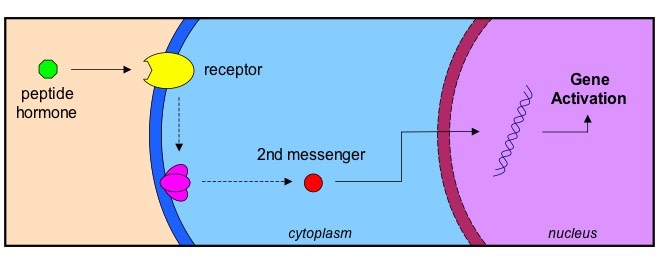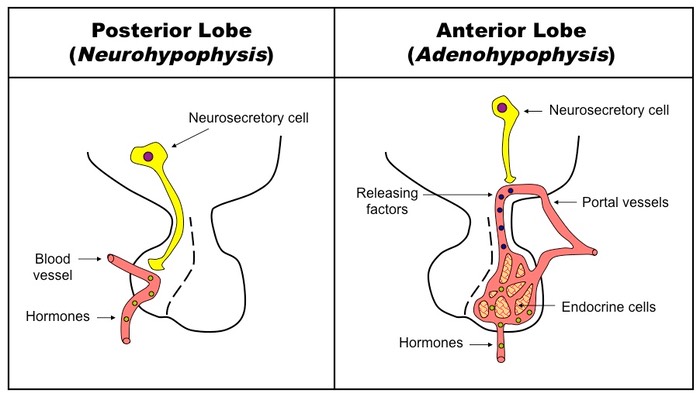H.1.1 State that hormones are chemical messengers secreted by endocrine glands into the blood and transported to specific target cells
The endocrine system is a control system of ductless glands that secrete chemical messengers called hormones, which circulate within the body via the bloodstream to affect specific target cells at distant organs

The endocrine system does not include exocrine glands, which are ducted and secrete substances for release into cavities, either inside the body or onto its outer surface
![]() The Endocrine System
The Endocrine System
H.1.2 State that hormones can be steroids, proteins or tyrosine derivatives, with one example of each

H.1.3 Distinguish between the mode of action of steroid hormones and protein hormones
Steroid Hormones
- Enter target cells through the plasma membrane (are lipophilic)
- Bind to receptor proteins in the cytoplasm and form a steroid / receptor complex which affects gene expression
- Can act directly as a transcriptional regulator

Protein Hormones
- Cannot enter target cells (are lipophobic)
- Binds to receptors on the surface of the plasma membrane, which activates second messengers within the cell
- Acts indirectly to change cellular activity (via signal transduction pathways)

H.1.4 Outline the relationship between the hypothalamus and the pituitary gland
Hypothalamus
- The hypothalamus plays an important role in integrating the nervous and endocrine systems in order to maintain homeostasis
- It receives information from nerves throughout the body and other parts of the brain and initiates appropriate endocrine responses
- The hypothalamus controls the release of hormones via the pituitary gland, which is comprised of two distinct lobes:
Posterior Pituitary
- The posterior lobe (neurohypophysis) releases hormones produced by neurosecretory cells of the hypothalamus
- These cells extend from the hypothalamus into the posterior lobe and release hormones into the bloodstream in response to nerve signals
- An example of a hormone released from the posterior pituitary is anti-diuretic hormone (ADH)
Anterior Pituitary
- The hypothalamus synthesises hormones called releasing factors, which are released into the portal vein that extends to the anterior lobe
- The releasing factors cause endocrine cells in the anterior pituitary to release specific hormones into the bloodstream to act on distant cells
- An example of a releasing factor is GnRH, which triggers the release of LH and FSH from the anterior pituitary
Comparison of the Relationship between the Posterior Pituitary and Anterior Pituitary

H.1.5 Explain the control of ADH (vasopressin) secretion by negative feedback
- Neurosecretory cells in the hypothalamus synthesise and transport ADH to the posterior pituitary gland where it is stored
- Osmoreceptors in the hypothalamus detect an increase in blood solute concentration when levels of water in the blood drop
- This may be caused by excessive sweating, too little water intake or too much salt intake
- In response to this nervous activation, ADH is released from the posterior pituitary and travels in the blood to the kidneys
- ADH makes the epithelium of the collecting ducts more permeable to water by upregulating the expression of aquaporins
- This increases the amount of water reabsorption by the kidneys, causing blood solute concentration to drop
- With a drop in blood solute concentration, ADH secretion is inhibited (negative feedback)
- If blood solute concentration is low (due to excessive water intake), the collecting duct remains impermeable to water and urine is dilute